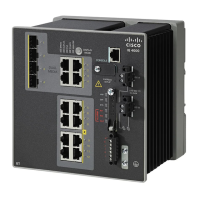Before connecting to the SFP module, be sure that you understand the port and cabling guidelines in Installing
and Removing SFP Modules, on page 28. See Cable and Connectors, on page 61 for information about the
LC on the SFP module.
Connecting to a Fiber Optic SFP Module
To connect a fiber-optic cable to an SFP module:
1. Remove the rubber plugs from the module port and fiber-optic cable, and store them for future use.
2. Insert one end of the fiber-optic cable into the SFP module port.
3. Insert the other cable end into a fiber-optic receptacle on a target device.
4. Observe the port status LED:
• The LED turns green when the switch and the target device have an established link.
• The LED turns amber while the STP discovers the network topology and searches for loops. This
process takes about 30 seconds, and then the port LED turns green.
• If the LED is off, the target device might not be turned on, there might be a cable problem, or there
might be a problem with the adapter installed in the target device. See Troubleshooting for solutions
to cabling problems
5. If necessary, reconfigure and restart the switch or the target device
Connecting to a 1000BASE-T SFP Module
To prevent ESD damage, follow standard board and component handling procedures.
Caution
To connect a CAT5 cable to a 1000BASE-T SFP module:
1. When connecting to servers, workstations, and routers, insert a four twisted-pair, straight-through cable
in the RJ-45 connector. When connecting to switches or repeaters, insert a four twisted-pair, crossover
cable.
When connecting to a 1000BASE-T device, use a four twisted-pair CAT5 cable.
Note
2. Insert the other cable end in an RJ-45 connector on a target device.
3. Observe the port status LED:
• The LED turns green when the switch and the target device have an established link.
• The LED turns amber while the STP discovers the network topology and searches for loops. This
process takes about 30 seconds, and then the port LED turns green.
• If the LED is off, the target device might not be turned on, there might be a cable problem, or there
might be a problem with the adapter installed in the target device. See Troubleshooting, on page 49
for solutions to cabling problems.
4. If necessary, reconfigure and restart the switch or the target device.
Cisco IE 4010 Switch Hardware Installation Guide
32
Switch Installation
Connecting to a Fiber Optic SFP Module

